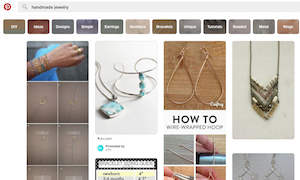You have a great product and you've set up your glossy, do-it-yourself online store with full eCommerce capability. You've done some marketing on social media and you're in business, ready to roll. What's next?
Orders start coming in and then — you have to ship them. How exactly does a small eCommerce entrepreneur like you handle shipping? Making and selling your own fishing lures, musical instruments or sweaters doesn't make you a logistics expert, after all.
When you're a very small business, shipping is likely a labor-intensive process involving your own two hands rather than an automated distribution warehouse, but there are tools that can help.
When you're a very small business, shipping is likely a labor-intensive process involving your own two hands rather than an automated distribution warehouse, but there are tools that can help.
Ridge Woods, 17-year-old founder of Woodsmen Guitar Co., is used to hands-on work. His online company builds custom, handcrafted guitars, which typically take two to three months to finish. Needless to say, shipping is hands-on as well.
Normally, when it's time to send an order, he says, "I pack the guitars myself to ensure that they are safe while they are being shipped." He tries to use the U.S. Postal Service "because they ship the fastest and gentlest with fragile items and objects."
For non-guitar merchandise that customers order online, Woods receives notifications through his mobile app and email notifications.
"I always ship from my workshop. None of the guitars ever leave the workshop before they are finished, and it's also the closest to our local USPS," Woods says. "I always try to have USPS pick it up from my shop to conserve time for building, but in some cases I have to take it to them because they can't pick it up in a short amount of time."
Woods started building guitars as a hobby when he was 15 and the endeavor evolved into an official business within the past year. Woodsmen has generated nearly $12,000 in sales for a $7,000 profit so far, he says. Woods recently upgraded his site to connect directly to Shippo, a shipping label-printing app, which helps a lot to get orders out the door quicker and reduce shipping costs.
"It's super easy to use and it's fast, which is why I use it. After I get an order, I put all the info into Shippo and it prints me a label. Super quick and easy," he explains.
Shippo works with UPS, FedEx, USPS, DHL and other major shippers. Businesses can get significant discounts off retail prices on domestic and international shipping. Shippo features automatic tracking, customer email notifications and bulk label printing and allows businesses to compare rates.
Other small business owners have come up with their own shipping routines.
Normally, when it's time to send an order, he says, "I pack the guitars myself to ensure that they are safe while they are being shipped." He tries to use the U.S. Postal Service "because they ship the fastest and gentlest with fragile items and objects."
For non-guitar merchandise that customers order online, Woods receives notifications through his mobile app and email notifications.
"I always ship from my workshop. None of the guitars ever leave the workshop before they are finished, and it's also the closest to our local USPS," Woods says. "I always try to have USPS pick it up from my shop to conserve time for building, but in some cases I have to take it to them because they can't pick it up in a short amount of time."
Woods started building guitars as a hobby when he was 15 and the endeavor evolved into an official business within the past year. Woodsmen has generated nearly $12,000 in sales for a $7,000 profit so far, he says. Woods recently upgraded his site to connect directly to Shippo, a shipping label-printing app, which helps a lot to get orders out the door quicker and reduce shipping costs.
"It's super easy to use and it's fast, which is why I use it. After I get an order, I put all the info into Shippo and it prints me a label. Super quick and easy," he explains.
Shippo works with UPS, FedEx, USPS, DHL and other major shippers. Businesses can get significant discounts off retail prices on domestic and international shipping. Shippo features automatic tracking, customer email notifications and bulk label printing and allows businesses to compare rates.
Other small business owners have come up with their own shipping routines.
Dang Shades, a sports-themed sunglasses company founded in 2007, uses PayPal's print and ship function and sends orders via U.S. Postal Service. PayPal "is what we have found the easiest," Utah-based company owner Chris Beresford, a competitive snowboarder, says.
PayPal allows multiple-USPS label printing, shipment tracking and confirmation, pre-filled packing slip printing and international shipping with Customs forms, according to its website. It integrates with UPS and other services, in addition to the USPS.
"With all orders via PayPal it's just one button that says ship order when you click on the transaction, and you put in the weight and dimensions of the package and you can choose either USPS or UPS, and the shipping fee comes directly out of your PayPal account," Beresford says.
Dang Shades has global distribution through retailers as well as online orders, with Beresford personally handling shipping to distributors and shops.
"It's all done out of my home. My basement is the warehouse as of right now. But I do have a friend who does the online store shipping for me out of Connecticut," Beresford says. "It's all done by hand. At first we used to hand write all of the addresses but USPS has made it very simple and user friendly."
Kimarie Santiago, creator and owner of the artisan-infused sea-salt business Saltopia, has seen sales double every year since her company's December 2011 founding. The business ships every day, and is especially busy around certain holidays, like Mother's Day.
Saltopia's regular employee base of four can grow to more than a dozen seasonally, which makes sense, given that packing and labeling remaining labor-intensive operations for the New Jersey-based company.
Santiago's business, which generally uses UPS or FedEx, handles all packing and shipping by hand. They print labels via a UPS machine that comes with their account. "However, we still need to implement the order details: address, weight, dimensions of the shipment," she says.
UPS and FedEx both pick up daily at Saltopia's facility, a service for which the specialty salt company pays weekly.
While Saltopia has investigated apps like Shippo, it hasn't used them because they "do not speak directly with the tools we use" for UPS and FedEx, says Santiago. While Shippo can integrate with the major shipping companies, it works with web-based versions, she says; Saltopia uses a software application that syncs directly with UPS.
"It negotiates rates daily for us to guarantee the best rates regularly. Plus it comes with a free printer that prints the labels: saves us on toner, paper and tape," she says.
As Entrepreneur noted in a guide to establishing a small-business shipping system, owners can look up pricing and services on websites of vendors such as UPS, FedEx, DHL and USPS, and talk to sales representatives to ask questions, including negotiating rates.
The article also suggests entrepreneurs find ways to rein in shipping costs, and be transparent about those rates, so that their online stores don't lose customers who might be unpleasantly surprised by a high fee at checkout.
PayPal allows multiple-USPS label printing, shipment tracking and confirmation, pre-filled packing slip printing and international shipping with Customs forms, according to its website. It integrates with UPS and other services, in addition to the USPS.
"With all orders via PayPal it's just one button that says ship order when you click on the transaction, and you put in the weight and dimensions of the package and you can choose either USPS or UPS, and the shipping fee comes directly out of your PayPal account," Beresford says.
Dang Shades has global distribution through retailers as well as online orders, with Beresford personally handling shipping to distributors and shops.
"It's all done out of my home. My basement is the warehouse as of right now. But I do have a friend who does the online store shipping for me out of Connecticut," Beresford says. "It's all done by hand. At first we used to hand write all of the addresses but USPS has made it very simple and user friendly."
Kimarie Santiago, creator and owner of the artisan-infused sea-salt business Saltopia, has seen sales double every year since her company's December 2011 founding. The business ships every day, and is especially busy around certain holidays, like Mother's Day.
Saltopia's regular employee base of four can grow to more than a dozen seasonally, which makes sense, given that packing and labeling remaining labor-intensive operations for the New Jersey-based company.
Santiago's business, which generally uses UPS or FedEx, handles all packing and shipping by hand. They print labels via a UPS machine that comes with their account. "However, we still need to implement the order details: address, weight, dimensions of the shipment," she says.
UPS and FedEx both pick up daily at Saltopia's facility, a service for which the specialty salt company pays weekly.
While Saltopia has investigated apps like Shippo, it hasn't used them because they "do not speak directly with the tools we use" for UPS and FedEx, says Santiago. While Shippo can integrate with the major shipping companies, it works with web-based versions, she says; Saltopia uses a software application that syncs directly with UPS.
"It negotiates rates daily for us to guarantee the best rates regularly. Plus it comes with a free printer that prints the labels: saves us on toner, paper and tape," she says.
As Entrepreneur noted in a guide to establishing a small-business shipping system, owners can look up pricing and services on websites of vendors such as UPS, FedEx, DHL and USPS, and talk to sales representatives to ask questions, including negotiating rates.
The article also suggests entrepreneurs find ways to rein in shipping costs, and be transparent about those rates, so that their online stores don't lose customers who might be unpleasantly surprised by a high fee at checkout.
 Dinah W. Brin A freelance reporter and writer based in Philadelphia, Pa., Dinah previously worked as a staff reporter for The Associated Press and Dow Jones Newswires.
Dinah W. Brin A freelance reporter and writer based in Philadelphia, Pa., Dinah previously worked as a staff reporter for The Associated Press and Dow Jones Newswires.







